1) I took a small portion of your matrix which looks like so:

2) We then take your matix and dynamically normalize it (see cte0), and that looks like this:

Now, for performance sake, if this is a static matrix, I would recommend that you actually store the data is this fashion.
3) Given your target values @X and @Y, we then need to determine the desired rows and columns (in cte1). The result looks like this:

- The fields and values are the desired Row/Column numbers
4) In cte2, we want to grab the X/Y ranges and values, and that looks like this:

4) The final query is a small matter of interpolation of the X/Y ranges/values. I used a UDF just to facilitate the math.
I should note that the results were validated as illustrated below:

OK, How about the Code?
I should add, that I left these portions as cte's so you can see how the individual parts work together. Certainly this can be compressed further (See Edit Below).
Declare @YourTable Table ([y] int,[x1.5] float,[x2.0] float,[x3.0] float,[x4.0] float)
Insert Into @YourTable Values
(1,1.050,1.055,1.057,1.057)
,(2,1.080,1.089,1.097,1.098)
,(3,1.091,1.103,1.114,1.446)
Declare @XML xml = (Select * from @YourTable for XML Raw)
Declare @Y float = 2.5
Declare @X float = 1.6
;with cte0 as (
Select RowNr = Dense_Rank() over (Order By r.value('@y','float'))
,ColNr = Dense_Rank() over (Order By convert(float,replace(attr.value('local-name(.)','varchar(100)'),'x','')))
,Y = r.value('@y','float')
,X = convert(float,replace(attr.value('local-name(.)','varchar(100)'),'x',''))
,V = attr.value('.','float')
From @XML.nodes('/row') as A(r)
Cross Apply A.r.nodes('./@*') AS B(attr)
Where attr.value('local-name(.)','varchar(100)') not in ('y') )
,cte1 as (
Select *
From (Select R1=max(RowNr),R2=max(RowNr)+1 From cte0 A where Y<@Y) A
Join (Select C1=max(ColNr),C2=max(ColNr)+1 From cte0 A where X<@X) B
on 1=1
)
,cte2 as (
Select X1 = max(case when C=1 then X end)
,X2 = max(case when C=2 then X end)
,Y1 = max(case when R=1 then Y end)
,Y2 = max(case when R=2 then Y end)
,Q11 = max(case when R=1 and C=1 then V end)
,Q12 = max(case when R=1 and C=2 then V end)
,Q21 = max(case when R=2 and C=1 then V end)
,Q22 = max(case when R=2 and C=2 then V end)
From (
Select *
,R=Dense_Rank() over (Order By RowNr)
,C=Dense_Rank() over (Order By ColNr)
From cte0 A
Cross Join cte1
Where RowNr between R1 and R2
and ColNr between C1 and C2
) A
)
Select Value = [dbo].[udf-Stat-Interpolate](@Y,Y1,Y2,[dbo].[udf-Stat-Interpolate](@X,X1,X2,Q11,Q12) ,[dbo].[udf-Stat-Interpolate](@X,X1,X2,Q21,Q22) )
From cte2
Returns
Value
1.0876
And Finally, the UDF if Interested
CREATE Function [dbo].[udf-Stat-Interpolate] (@PosNr float,@PosMin float,@PosMax float,@ValMin float,@ValMax float)
Returns Float as
Begin
Return (((@PosNr-@PosMin)/(@PosMax-@PosMin)*(@ValMax-@ValMin)))+@ValMin
End
Edit - If matrix is stored as illustrated above (#2)
Declare @Y float = 2.5
Declare @X float = 1.6
Select Value = [dbo].[udf-Stat-Interpolate](@Y,Y1,Y2,[dbo].[udf-Stat-Interpolate](@X,X1,X2,Q11,Q12),[dbo].[udf-Stat-Interpolate](@X,X1,X2,Q21,Q22) )
From (
Select X1 = max(case when C=1 then X end)
,X2 = max(case when C=2 then X end)
,Y1 = max(case when R=1 then Y end)
,Y2 = max(case when R=2 then Y end)
,Q11 = max(case when R=1 and C=1 then V end)
,Q12 = max(case when R=1 and C=2 then V end)
,Q21 = max(case when R=2 and C=1 then V end)
,Q22 = max(case when R=2 and C=2 then V end)
From (
Select *
,R=Dense_Rank() over (Order By RowNr)
,C=Dense_Rank() over (Order By ColNr)
From YourTable A
Cross Join (
Select *
From (Select R1=max(RowNr),R2=max(RowNr)+1 From YourTable A where Y<@Y) A
Join (Select C1=max(ColNr),C2=max(ColNr)+1 From YourTable A where X<@X) B on 1=1
) B
Where RowNr between R1 and R2
and ColNr between C1 and C2
) A
) A






